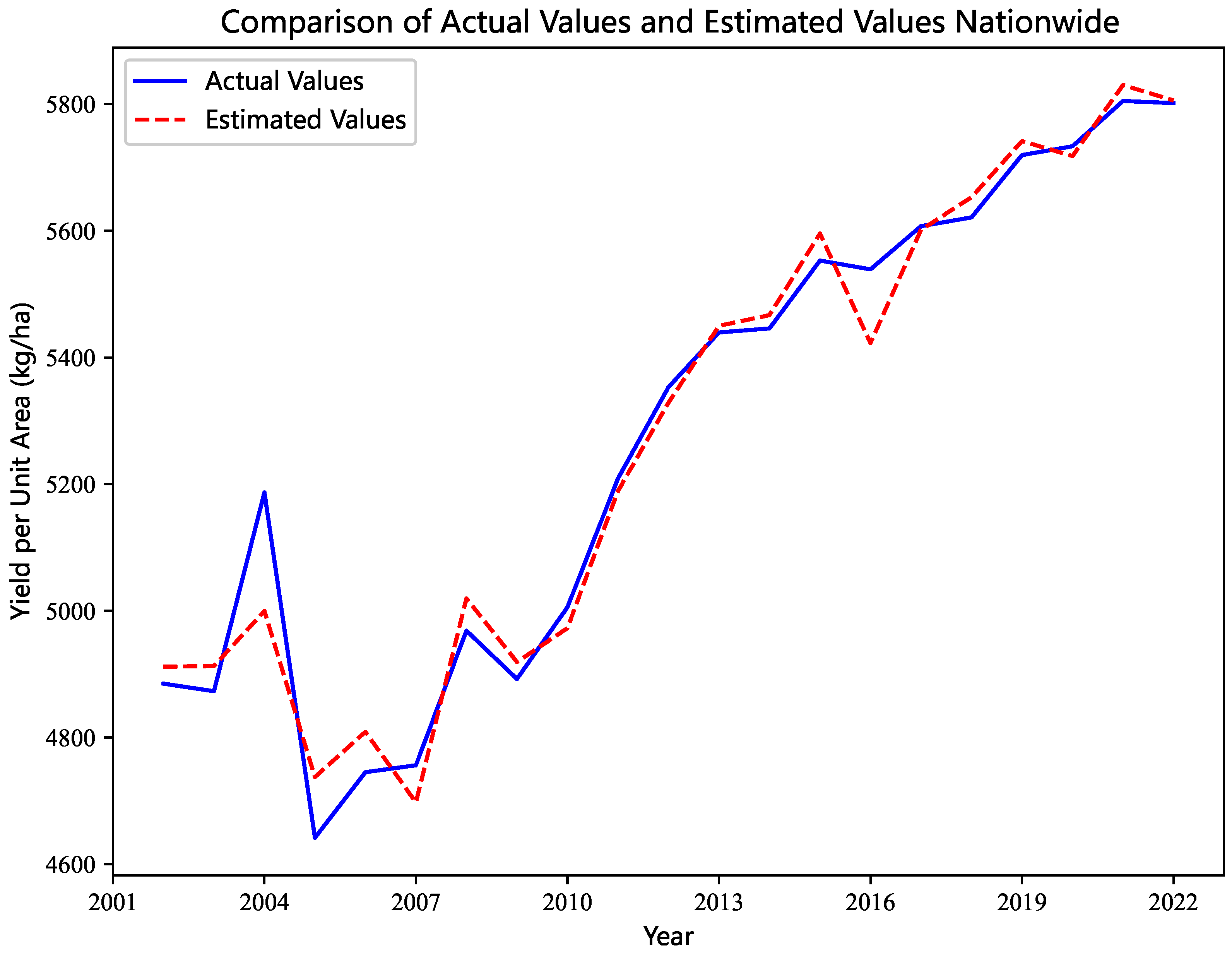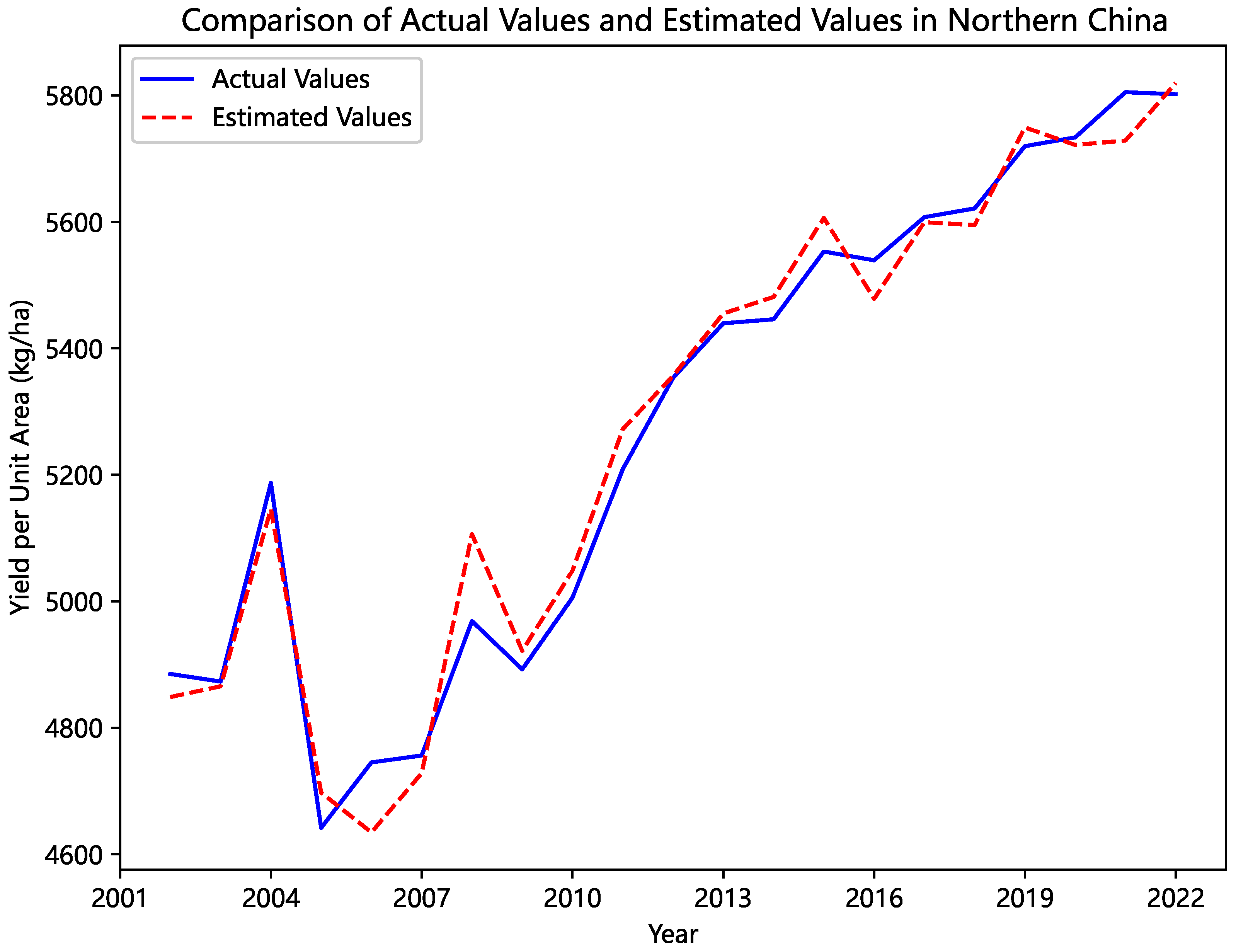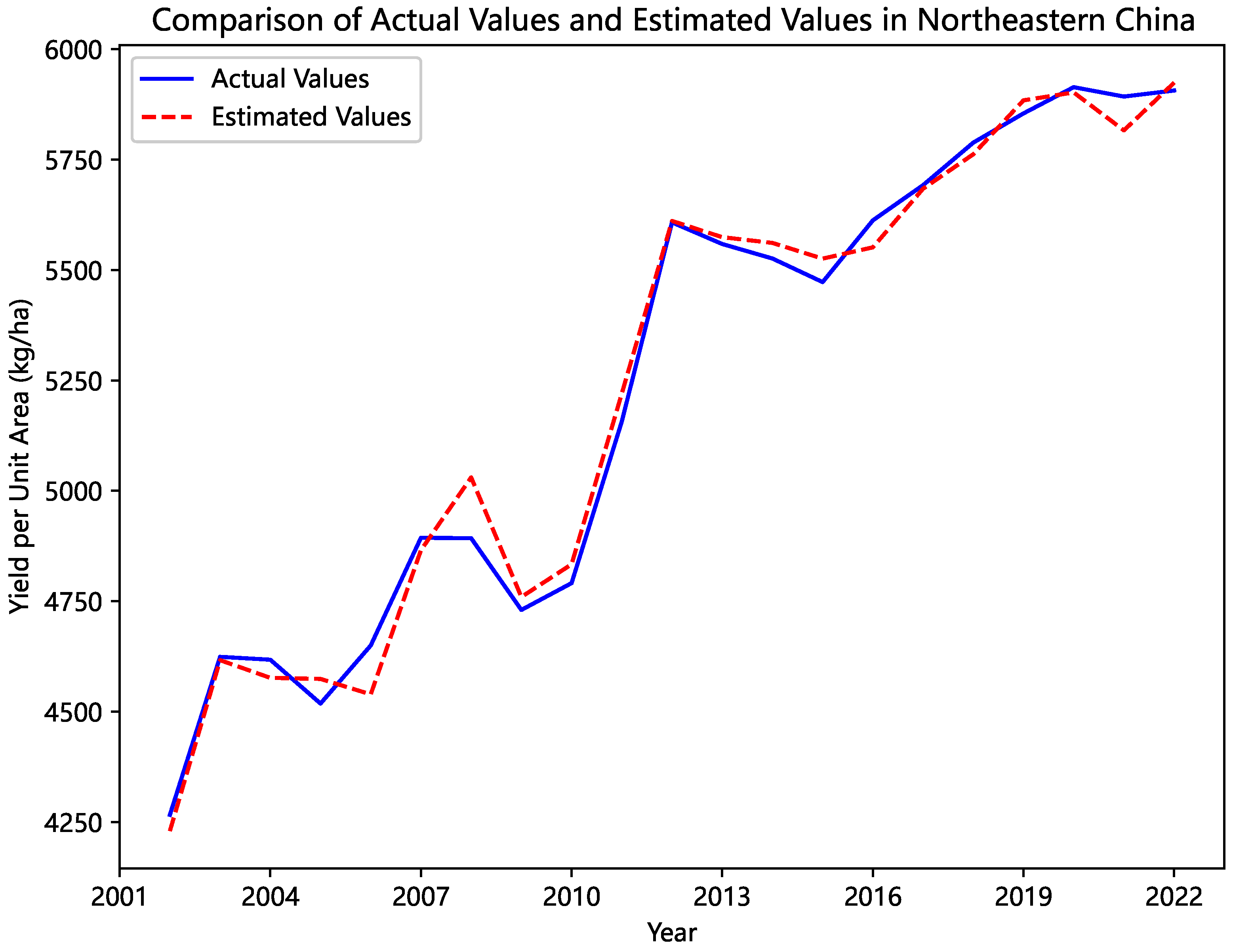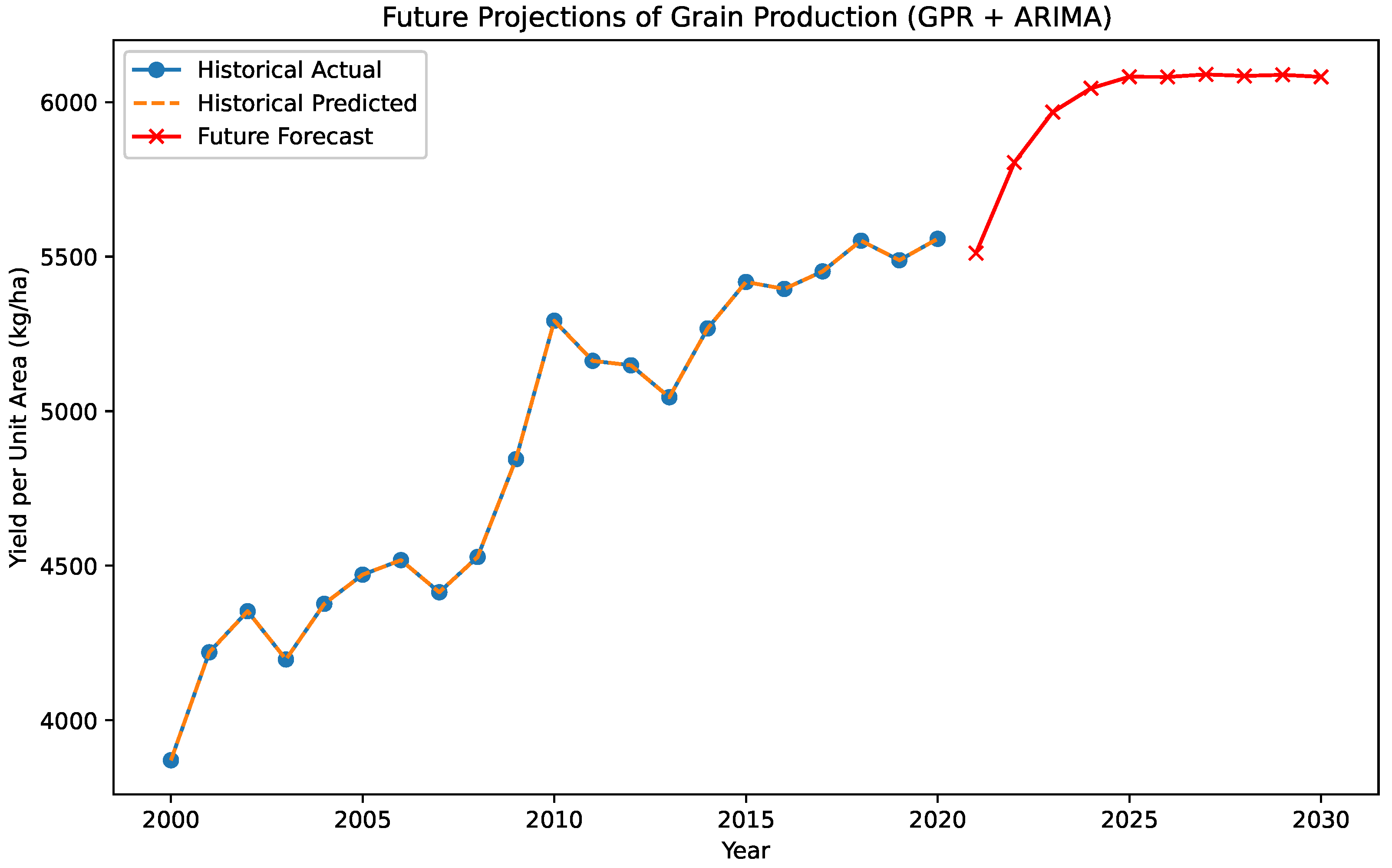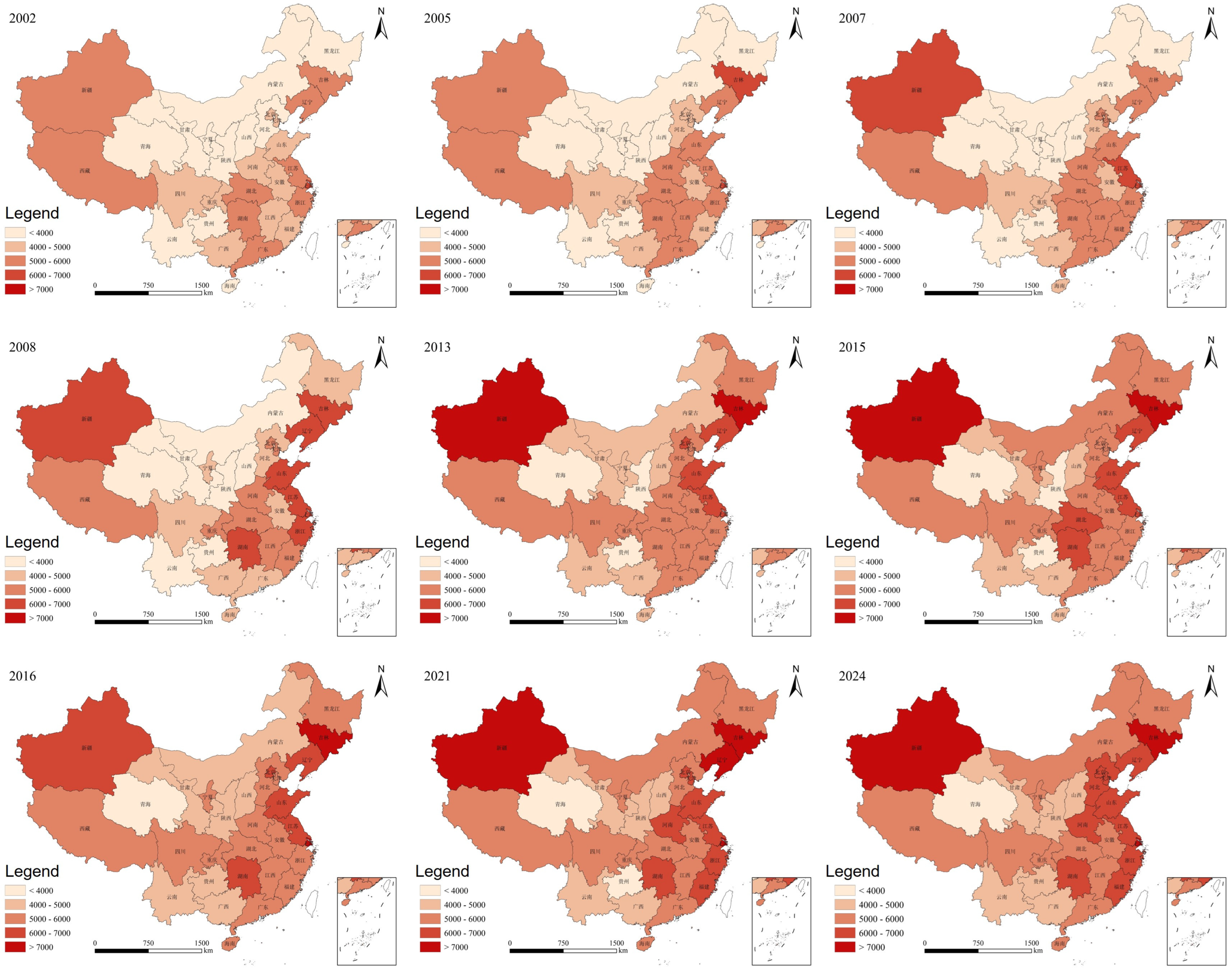To systematically analyze the interactive impacts of climate risks and production factors on grain output, this section constructs a multidimensional analytical framework based on the production function model. It incorporates panel data from the past two decades across the nation and three major grain-producing regions, examining the historical evolution, trend forecasting, and spatiotemporal disparities.
4.1. Historical Evolution Analysis of Grain Production
Figure 1 illustrates the actual changes in national grain production from 2002 to 2022, alongside the corresponding linear-log fitting model. Analyzing from a historical perspective, the unit area grain yield in China exhibited an overall upward trend during the period from 2002 to 2022, although it was characterized by significant fluctuations and phase changes [
30]. Specific results are as follows:
In the period from 2002 to 2004, the transition from market-oriented agricultural policies to protective regulation marked a critical juncture. Following China’s accession to the World Trade Organization, low-priced international grains flooded the domestic market, impacting local planting income and creating instability in farmers’ production expectations. Concurrently, a continual reduction in arable land resources, compounded by extreme weather events such as the catastrophic floods in the Huai River Basin, exposed the vulnerabilities of the traditional agricultural model. Although the level of agricultural mechanization improved, issues such as aging irrigation infrastructure and weak disaster prevention systems limited production efficiency, resulting in a “V-shaped” volatility in unit area yields, initially declining then rising. The fluctuations in production during this period highlighted the fragility of the agricultural production system during the policy void, setting the stage for subsequent protective policies.
From 2004 to 2014, this period was marked as a golden growth phase driven by policy incentives. The institutional reforms, epitomized by the abolition of the agricultural tax, ushered in a new phase of policy-driven grain production. The “policy triangle” comprising fiscal subsidies, price support, and agricultural insurance effectively stimulated production enthusiasm: subsidies for agricultural machinery facilitated a leap in mechanization rates, minimum purchase price policies stabilized planting income expectations, and the promotion of superior seeds and irrigation infrastructure enhanced technological empowerment. These measures prompted a stair-step increase in unit area yields, with an average annual growth rate significantly surpassing that of the preceding period. However, the drawbacks of an overly input-dependent development model gradually became apparent—the excessive use of fertilizers and pesticides led to soil degradation, resulting in conflicts between grain stockpiling and ecological pressures, ultimately culminating in the conundrum of “increased production without increased income” around 2013, signaling diminishing marginal returns for this strategy.
The period from 2014 to 2020 marked a transition towards quality-driven transformation in supply-side reform. Faced with resource and environmental constraints, as well as structural contradictions in “three increases” (production area, yield, and input), policy orientation began to shift toward quality and efficiency. The implementation of the “dual reduction” initiative on fertilizers and pesticides directly restrained extensive production practices, while the promotion of high-standard farmland construction and water-saving irrigation technologies enhanced disaster resilience. Reforms in corn storage policies pressured adjustments to planting structures, with yield breakthroughs in crops such as soybeans partially offsetting the impacts of reduced acreage. During this phase, the growth rate of unit area yield noticeably slowed, yet the amplitude of fluctuations decreased, reflecting a transformation in policy adjustment from a singular focus on yield to a balance between ecological benefits. Supply-side structural reforms in agriculture aimed to eliminate ineffective supply and enhance the provision of green, high-quality products, extending food security towards sustainable development.
From 2020 to 2022, this period experienced dual impacts from the COVID-19 pandemic and frequent extreme weather events, resulting in a notable decline in the stability of grain production. The growth rate of grain output further decelerated and even exhibited slight decreases, indicating that after reaching a certain high level, further increases in grain production face heightened environmental and economic pressures, necessitating new policy guidance and technological support.
The fitted values for unit area grain production across the country were derived from various methods, including gradient descent, ridge regression, lasso regression, and elastic net regression, with the optimal fitting results selected. Transitioning from ridge regression to elastic net, the regularization strategies evolved from a single constraint to a multi-objective coordination approach. The fitting results are expressed as follows:
where the variables
correspond to the area affected by typhoons, frost, drought, floods, total agricultural machinery power, total sown area for grain, irrigated arable land area, amount of fertilizer applied, and temperature, respectively. The parameter values are presented in
Table 2:
In this context, reflects the influence of the corresponding variable on grain yield: a positive indicates a positive impact on grain yield, with larger values signifying a greater beneficial effect. Conversely, a negative denotes a negative impact on grain yield, where a larger absolute value implies a more substantial adverse effect. Furthermore, the (coefficient of determination) is 0.974, indicating a very good fit for the model, while the (Root Mean Squared Error) is 60.9, suggesting that the predicted values deviate minimally from the actual values. The fitted model for the nation demonstrates that water conservancy construction is a crucial pillar for food security, with the contribution of irrigated arable land to yield significantly exceeding that of other factors. The fitted model for the nation demonstrates that water conservancy construction (which includes the development of infrastructure such as dams, reservoirs, and irrigation canal networks) is a crucial pillar for food security, with the contribution of irrigated arable land to yield significantly exceeding that of other factors. This underscores the strategic significance of the principle “to stabilize production, one must first manage water.” Regarding disaster impacts, the negative effects of typhoons and droughts are widespread; however, regional variations are masked by the overall dataset, indicating a need for localized disaster prevention and control policies. The potential threats posed by climate warming at the national level are less pronounced than those suggested by regional models, yet long-term vigilance is warranted against the trend of increasing extreme weather events. Additionally, the mere expansion of sown areas contributes limited benefits to average yield improvements, and may even lower the overall average yield, as expansion typically occurs onto less productive ‘marginal land’. Future efforts should prioritize technological innovation and the efficiency of resource utilization over reliance on mere scale expansion.
Figure 2 illustrates the actual changes in grain production in South China from 2002 to 2022, along with the corresponding linear-log fitting results. During this period, the unit area yield of grain crops in South China exhibited an initial decline followed by an increase, ultimately stabilizing within a high platform with fluctuations.
From 2002 to 2003, the unit area grain yield in South China saw a significant decrease, coinciding with a phase of policy adjustment and transformation in China’s agricultural sector. At that time, the marketization reform of the national grain circulation system was intensifying, leading to depressed grain prices and persistently low profitability for farmers engaged in grain production. This severely undermined farmers’ enthusiasm for grain cultivation, prompting many to switch to other cash crops or abandon their fields. Moreover, the implementation of ecological protection policies, such as “grain-for-green”, significantly reduced the area under grain cultivation, exacerbating structural imbalances in grain production. Concurrently, due to relatively underdeveloped agricultural mechanization and infrastructure, South China’s ability to mitigate and adapt to disasters was weak. After facing prolonged droughts, floods, and localized frost disasters, the stability of grain production drastically declined.
From 2004 to 2015, the unit area grain yield in South China entered a period of rapid growth, marked by a pivotal restructuring of the food security strategy at the top level, supported by a series of beneficial agricultural policies. The abolition of the agricultural tax and the establishment of direct subsidy systems redefined the distribution of interests between the government and farmers. The implementation of minimum purchase price policies stabilized market expectations and encouraged the reinvestment of production factors into grain production. Amid an upgrade wave in infrastructure, the networking of water conservation projects significantly enhanced disaster resilience, while the construction of high-standard farmland unlocked productivity in mid- to low-yield fields. Breakthroughs in the breeding of super rice led a technological revolution, and innovations in supportive cultivation models elevated the yield ceiling. During this stage, the rate of mechanization surpassed critical thresholds, while cooperative models effectively bridged the gap between smallholder farms and modern agriculture. Although disasters such as typhoons and floods occurred, the compensation mechanisms for disaster losses and emergency management systems became increasingly sophisticated, significantly improving resilience in capacity recovery.
In the 2016 to 2022 period, the unit area grain yield in South China experienced high volatility. The agricultural supply-side reform shifted the development logic from a focus on increased production to prioritizing quality and efficiency. The implementation of crop rotation and fallow systems triggered profound adjustments in planting structures, where reductions in double-cropped rice areas and expansions in specialty dryland crops created a yield offset effect. The reduction in fertilizer and pesticide usage compelled a transformation in production methods, and widespread adoption of biological control and precision fertilization technologies redefined pathways to increase yield. The aging labor force spurred innovations in socialized service provisions, with management models maintaining baseline yields through standardized operations. In the context of climate change, the frequency of extreme weather events surged, and phenomena such as El Ni?o led to cascading disaster reactions; however, smart warning systems and the promotion of resilient varieties effectively cushioned the fluctuations in yield. The essential nature of yield stabilization during this phase reflects a dynamic balance between hard constraints of resource and environmental factors and the soft support of technological substitutes. The fitted results using the logarithmic linear model are as follows:
The variables
correspond to the following factors: the area affected by typhoons, the area affected by frost, the area affected by drought, the area affected by floods, total agricultural machinery power, total sown area for grain, irrigated arable land area, amount of fertilizer applied, and temperature. The estimated values of the parameters
are presented in
Table 3:
Additionally, the (coefficient of determination) is 0.953, indicating a good fit for the model, (Root Mean Squared Error) is 58.9, suggesting that the predicted values deviate minimally from the actual values. The fitted model for South China reveals that agriculture in the region faces significant impacts from floods and typhoons. The destruction caused by floods during the rainy season is particularly pronounced, with inadequate drainage systems leading to widespread crop damage. Typhoon disasters cause persistent reductions in output through the direct destruction of crops and infrastructure. In terms of strategies to increase production, advancing mechanization is of paramount importance, particularly as labor shortages may necessitate improvements in production efficiency. In contrast, the marginal benefits of irrigation and fertilizer usage are relatively low, likely due to the region’s abundant rainfall and limited soil characteristics. Moving forward, it is essential to strengthen disaster warning systems and promote flood-resistant crops while optimizing solutions to address the conflict between mechanization and land fragmentation.
Figure 3 illustrates the actual changes in grain production in North China from 2002 to 2022, alongside the corresponding linear-log fitting results. An analysis using a historical perspective shows that the unit area grain yield in North China exhibited a generally upward trend characterized by fluctuations, with distinct variations across different periods. This change reflects the interactive influences of policy environments, agricultural inputs, technological development, and natural disasters. Between 2002 and 2005, grain production in North China was largely in a declining fluctuation phase. During this time, agricultural enthusiasm was low, infrastructure development was relatively underwhelming, mechanization was insufficient, and agricultural capacity to withstand natural disasters was limited. Additionally, the nation was undergoing market-oriented adjustments in the grain circulation system, leading to depressed grain prices. Policies such as “grain-for-forest” reduced the area planted in grains, severely discouraging farmer engagement in grain production and further exacerbating the downward trend in grain yields. During this period, extreme weather events, particularly severe droughts, significantly weakened the crop growth environment and contributed to further declines in yields.
Starting in 2004, the agricultural production environment in North China experienced substantial improvements, leading to the rapid recovery of grain yields, which entered a phase of fast growth. The government launched a series of robust agricultural support policies, including exemptions from agricultural taxes, grain production subsidies, minimum purchase price policies, and subsidies for agricultural machinery. These measures effectively enhanced farmers’ motivations to cultivate grain. Additionally, significant increases in agricultural inputs and the promotion of technology led to a notable rise in mechanization, with advancements in irrigation infrastructure greatly improving the capacity to withstand droughts and other natural disasters. Agricultural technological progress, centered on the promotion and application of high-quality, high-yield crop varieties, effectively drove steady increases in grain production and further safeguarded food security.
From 2013 to 2019, the growth rate of grain yields began to slow, entering a phase of fluctuating adjustment. Influenced by increasing pressures from resource and environmental constraints and the government’s policies aimed at structural adjustments in grain production, the planting structure in North China began to shift from a focus on maximizing grain output to emphasizing quality and sustainable development. Some regions implemented crop rotation and fallowing practices, resulting in changes to the structure and area planted in grains. At the same time, frequent natural disasters, particularly droughts, floods, and low-temperature frost events, exacerbated short-term yield fluctuations. However, thanks to advancements in irrigation infrastructure and agricultural technology promotion, overall grain production remained at a high level, demonstrating strong resilience to disasters.
Entering the period from 2020 to 2022, grain production stabilized at a high level. In the context of the COVID-19 pandemic and changing international circumstances, the government placed greater emphasis on food security, further enhancing the policy support system and strengthening technological backing. Agricultural production methods shifted towards greener and more efficient practices, with accelerated high-standard farmland construction enhancing the stability and sustainability of grain production. Although extreme weather occasionally affected yield stability, overall, through policy guidance, technological support, and optimized production structures, the grain production capacity in North China remained stable and gradually improved during this high plateau phase. The fitted results using the logarithmic linear model are as follows:
In this model, the variables
correspond to the following factors: the area affected by typhoons, the area affected by frost, the area affected by drought, the area affected by floods, total agricultural machinery power, total sown area for grain, irrigated arable land area, amount of fertilizer applied, and temperature. The estimated values of the parameters
are shown in
Table 4:
Additionally, the (coefficient of determination) is 0.965, indicating an excellent fit for the model, while the (Root Mean Squared Error) is 53.8, suggesting that the predicted values deviate minimally from the actual values. The fitted model for North China reveals that grain production in the region is primarily threatened by drought and extreme temperatures. Drought is the leading factor contributing to yield declines, as frequent water shortages severely restrict crop growth. Furthermore, winter frost and abnormally high temperatures exacerbate the risk of reduced yields, highlighting the dual pressure of climate change on agriculture in North China. In terms of positive drivers, expanding irrigated land is a core strategy for enhancing yields, with improvements in water conservation infrastructure effectively mitigating the impacts of drought. However, the benefits of increasing agricultural mechanization and fertilizer usage appear limited, indicating that agricultural production efficiency in North China is nearing a bottleneck given current technological conditions. Thus, there is a pressing need to shift towards the development of water-saving technologies and the breeding of resilient crop varieties.
As shown in
Figure 4, between 2002 and 2007, the unit area grain yield in Northeast China exhibited a relatively stable growth trend. However, around 2005, a certain degree of fluctuation began to appear, with actual yields slightly declining compared to fitted values, reflecting the inability to maintain steady growth in grain production. During this period, natural disasters such as typhoons and frost significantly impacted grain yields, leading to declines in some years. For instance, in 2004 and 2005, the occurrence of extreme weather events, such as frost, resulted in decreased grain production.
Starting in 2007, grain yields began to show a rising trend, reflecting gradual improvements in agricultural technology and infrastructure in Northeast China, particularly in investments and advancements in irrigation technology and mechanical power. From 2008 to 2013, the unit area grain yield in Northeast China experienced a dramatic increase, with actual yields significantly surpassing fitted values. This sharp growth during this period can be attributed to several key factors. Firstly, policy support played a crucial role: after 2008, the government implemented a series of agricultural support policies, including subsidies for grain production and the promotion of mechanization. The implementation of these policies significantly enhanced agricultural productivity in Northeast China, leading to substantial increases in unit area yields. Secondly, agricultural technological innovations, including the widespread application of modern agricultural techniques—particularly improvements in fertilizer use, mechanization, and irrigation systems—contributed to marked increases in grain production efficiency. Thirdly, favorable climatic conditions during this period, with minimal occurrences of extreme weather events such as frost and flooding, provided a conducive environment for grain production. Therefore, the significant rise in grain yields during this time resulted from a positive interaction among policies, technology, and climatic conditions.
However, after 2014, the growth rate of grain yields in Northeast China noticeably slowed. Although production levels remained high, the pace of increase significantly diminished. This slowdown can be attributed to the constraints imposed by land resources, as agricultural land in the region approached saturation, limiting further enhancements in productivity. As land utilization efficiency gradually approached its limit, the growth of grain yields stabilized. Additionally, during this period, the climate experienced considerable fluctuations, including frequent droughts and flooding, which directly affected agricultural productivity. In some years, yield declines were observed due to drought impacts, contributing to a slowdown in growth.
From 2018 to 2022, the unit area grain yield in Northeast China exhibited a relatively stable growth trend, albeit with some fluctuations. This period was characterized by sustained support for agricultural technology and policies; however, the driving forces behind yield growth were noticeably weakened due to climate change and limitations in land resource utilization efficiency. Despite ongoing investments in irrigation technology, fertilizer application, and mechanization helping to maintain growth, the incremental improvements became smaller, making it more challenging to achieve the substantial increases in yields seen during 2008–2013. Additionally, the exacerbation of climatic fluctuations became increasingly significant, with Northeast China experiencing more extreme weather phenomena such as drought and frost, which led to yield declines in certain years—particularly in 2019 and 2020, when drought conditions resulted in reduced unit area yields.The fitted results using the logarithmic linear model are as follows:
In this model, the variables
correspond to the following factors: the area affected by typhoons, the area affected by frost, the area affected by drought, the area affected by floods, total agricultural machinery power, total sown area for grain, irrigated arable land area, amount of fertilizer applied, and temperature. The estimated values of the parameters
are shown in
Table 5:
Additionally, the coefficient of determination is 0.9897, indicating an excellent fit for the model, (Root Mean Squared Error) is 54.0, signifying that the predicted values deviate minimally from the actual values. The fitted model for Northeast China reveals that grain production in the region is primarily threatened by frost and drought. Frost is a critical factor contributing to yield declines, particularly spring frost, which adversely affects early crop growth and significantly slows down the growth rate, thereby impacting overall production. Drought is also an important constraint on yield growth, with frequent drought conditions leading to insufficient water supply, which negatively impacts the normal growth and development of crops, especially in years with unstable precipitation. Relatively, the adverse effects of rising temperatures on crop growth are also becoming more pronounced. During high-temperature seasons, the grain filling period of crops is compressed, resulting in reduced yields. On the positive side, the expansion of irrigated land plays a crucial role, as improved water resource allocation effectively alleviates the impacts of drought and ensures the availability of water necessary for crop growth. However, enhancements in agricultural mechanization and fertilizer usage have had a limited effect on boosting yields, suggesting that agricultural production in Northeast China is nearing a bottleneck given the current technological constraints. Moving forward, there is a pressing need to strengthen the development of water-saving irrigation technologies and drought-resistant, cold-tolerant crop varieties to address the challenges posed by increasingly complex climate changes and pressures on land resources.
4.3. Analysis of the Spatiotemporal Evolution of Grain Production
Grain production is a crucial indicator of agricultural productivity and a key factor in ensuring national food security. From 2002 to 2024, influenced by multiple factors such as agricultural technological advancements, climate change, and policy adjustments, the spatiotemporal evolution of grain production across various provinces in China (excluding Hong Kong, Macau, and Taiwan) has demonstrated significant regional disparities [
32], as illustrated in
Figure 6.
The changes in grain production across different provinces from 2002 to 2024 exhibit significant disparities. Notably, provinces such as Inner Mongolia, Hebei, Ningxia, and Gansu have demonstrated remarkable increases in grain yields, primarily attributable to agricultural technological innovations and supportive policies. In Inner Mongolia, the grain yield per unit area rose from 3240 kg in 2002 to 5620 kg in 2024, reflecting an impressive increase of 73.3%. This growth is primarily driven by the introduction of modern agricultural facilities and advancements in irrigation technology. Similarly, Hebei’s grain yield per hectare increased from 43,780 kg to 6980 kg, a growth of 59.6%, closely linked to sustained investments in agricultural technology, mechanization, and water resource management. Additionally, Ningxia and Gansu reported growth rates of 58.4% and 57.3%, respectively, benefiting from the development of water-saving irrigation and agricultural mechanization. In contrast, traditional grain-producing regions, such as Northeast China, have experienced a gradual slowdown in growth, revealing diminished potential for yield increases under the dual pressure of increasingly constrained land resources and declining marginal returns on technological advancements.
With changes in grain production, the spatial pattern of grain production is also undergoing significant transformation. The growth rates in traditional grain-producing areas, such as Northeast and North China, are slowing down annually, while emerging high-yield areas, including the Northwest region and some southern provinces, are experiencing accelerated grain production growth. For instance, Heilongjiang continues to see an increase in grain yield, but the overall increase from 2002 to 2024 is only 45.2%, indicating limited growth potential and the need for more effective methods to enhance yield rates. In contrast, Hebei and Tianjin have exhibited substantial increases in yields, with Hebei’s total increase reaching 59.6%, demonstrating rapid growth in grain production in North China driven by modern agricultural technologies and policies. The Northwest region, particularly Inner Mongolia, Ningxia, and Gansu, has consistently increased grain yields thanks to superior irrigation technology and improved agricultural infrastructure, gradually replacing parts of Northeast and North China as new high-yield areas. The grain yield increases in the Northwest region are significant, showing greater stability in growth rates during certain years.
Over the past two decades, the distribution of high-yield grain production areas in China has been undergoing a notable shift. While Northeast and North China maintain high grain yield levels, their growth rates have exhibited a consistent decline over the past twenty years, with some years even experiencing stagnation in yield growth. In contrast, the Northwest region, particularly Inner Mongolia, Ningxia, and Gansu, has emerged as a new high-yield area due to ongoing investments in modern agricultural technology, water-saving irrigation, and mechanization. The yield increases in the Northwest region far exceed those of traditional grain-producing areas, suggesting its growing significance in future food production. Especially under the influence of climate change, the arid regions in the Northwest are expected to further enhance their grain production capabilities through technological innovation and effective water resource utilization, thereby altering the national spatial pattern of grain production.
